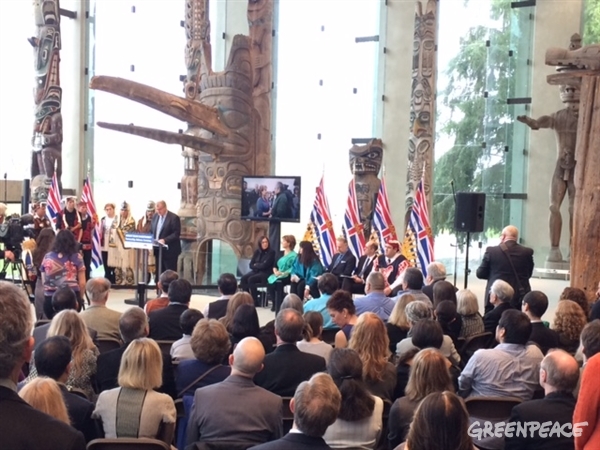It’s Monday and I am standing in a room, waiting to speak at the media conference that announces the completion of the Great Bear Rainforest Agreements – safeguarding an area of forest larger than Vancouver Island, bigger than Belgium. This day is twenty years in the making.
The drumming by members of Nanwakolas Council begins. A line of people, including me, begin to wind their way through the hallways of the grand Museum of Anthropology in Vancouver. We enter the majestic Raven and the First Men Gallery, with its towering totem poles. The room is filled with cameras and over a hundred guests. This isn’t your typical media conference.
It’s at that point, the significance of what we have achieved with the fulfillment of the Great Bear Rainforest Agreements fully sinks in.
We have collectively, over a twenty year period, managed to safeguard a massive area of rainforest from logging – forever. And we have done so while respecting First Nations interests and supporting them in gaining more control over decision-making over the future of their traditional territories.

At the media conference I represented Greenpeace, ForestEthics and Sierra Club BC, the members of the Rainforest Solutions Project – the core team that has negotiated, campaigned and worked tirelessly to come to and then implement the Agreements.
When the drumming started I also realized that I was not only speaking for the current generation of campaigners at Greenpeace, ForestEthics and Sierra Club BC, but also representing 20 years of campaigners, activists, volunteers, supporters, donors and organizers who have contributed to our campaign to safeguard the Great Bear Rainforest. I was standing on many shoulders as I made my way up to the podium.
We have given rainforest wolves, spirit bears, forest frogs and marbled murrelets a fighting chance of survival. We have saved towering sitka spruce and 1000 year old cedars from the chainsaws. We have helped advance the well-being of communities in the forest.
 And, equally as important, we have created a model that can be replicated and used elsewhere in the world where forest conflicts rage on. The success of the Great Bear Rainforest campaign and the agreements represents hope for the Boreal Forest and for the rainforests of the Amazon, Indonesia and Congo. If we can do it in the Great Bear Rainforest, I know we can succeed in other places in the world.
And, equally as important, we have created a model that can be replicated and used elsewhere in the world where forest conflicts rage on. The success of the Great Bear Rainforest campaign and the agreements represents hope for the Boreal Forest and for the rainforests of the Amazon, Indonesia and Congo. If we can do it in the Great Bear Rainforest, I know we can succeed in other places in the world.
The cameras flashed, the speakers stood up and said their inspiring words (you can view some clips here) and then we concluded with questions. The media conference closed with a round of applause that I’d like to think could be heard all the way up the coast. It wasn’t about what we said in that hall in Vancouver. Rather it’s about what we have accomplished together over the past twenty years.
I had closed my speech by saying: “We have overcome the seemingly impossible. Together.”
That about sums it up.
Check out video highlights from the media conference.
Read more about the Great Bear Rainforest Agreements and the history of Greenpeace’s campaign.
— Richard Brooks is the coordinator of Greenpeace’s Forest Campaign —
